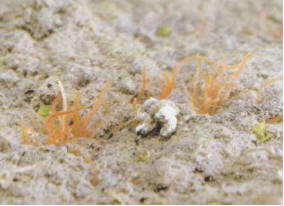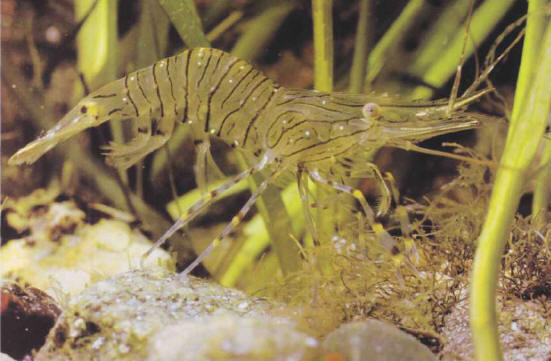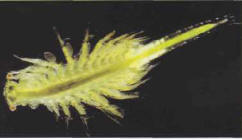LIVE PREY
These are ideal food items for carnivorous fish: they retain all their nutritional
value and move around to attract the fish. They are a problem to keep as they only
last a few days, but they can be frozen.

Frozen smelts
DRIED DAPHNIAS
These were once very popular - so many aquarists have started with them! Nowadays
they are out of fashion; in fact they are not the ideal food for fish and it is
best not to use them. More complete and suitable products, particularly those in
the form of flakes, are now available, even for goldfish.
LIVE PREY AND HOME PREPARATIONS
The artificial food on the market these days is very effective for aquarium fish.
To diversify and balance their requirements, they can also be served some of the
small, live prey that are commercially available - an important supply of vitamins
and mineral salts - or fresh food or homemade mixtures.
One of the best fresh foods: mussels
This mollusk, prized by humans, is equally appreciated by fish, especially those
marine species that refuse artificial food. Widely available, inexpensive, easy
to freeze, mussels are a top-class dish: they are rich in proteins and carbohydrates,
with few lipids. Furthermore, they contain many minerals (such as calcium, phosphorus,
magnesium, iron) and even vitamin C, which plays an important role in the fight
against disease. Mussels must be well cooked before using and their shells and connective
filaments removed. Cut them into pieces before distributing or freezing them.
Homemade food
An aquarist can easily make his or her own fish food - the possibilities are
enormous. The following recipe is just one of many.

Cooked mussels, frozen or otherwise, provide both practical
and nourishing fare.
Take some cooked white meat (chicken, turkey, ham) and some seafood (mussels,
cockles), also cooked, and mince them with a little water to make a homogenous paste.
A vitamin supplement, available from aquarium stores, can be added during this process.
This mixture can then be mixed with gelatin (from a sachet of powder, for example)
so that the paste does not break up in the water, as this may become a source of
pollution. One portion can be distributed immediately, while the rest can easily
be frozen in ice trays. The models designed for small ice cubes are particularly
recommended for making a large number of small portions. Once frozen, they can be
slipped out of the ice trays and bagged up in freezer bags for use as required.
Bloodworms
In fact, these are not worms but the aquatic larvae of various species of nonbiting
mosquitoes. They are also commonly used as bait in fishing. Although it is sometimes
thought that they live in mud, they are actually found in the water of areas that
are well endowed with organic matter. It is useless trying to collect them yourself,
but they are sold in the aquarium trade. They keep for a few days in the refrigerator,
wrapped in moist newspaper. They are a good source of nutrition, as they are rich
in protein.

Rich in proteins, bloodworms are a prey much appreciated
by carnivorous fish.
Tubifex worms
These are worms that are gathered from the mud in environments rich in organic
matter. Some people think that they represent a risk when they are introduced into
an aquarium, as they may carry undesirable bacteria. This risk is very slight, however,
and there have been no reports of any serious incidents. The specimens which are
commercially available can be kept for a few days in the refrigerator, in domestic
water, but it is essential that this water is changed every day.

Tubifex in a natural setting.

Tubifex worms can be distributed to fish by means of a special
accessory.
Shrimps
Flowing and welloxygenated fresh water are home to small river shrimps of up
2 cm that swim along the banks. These are rarely sold live, but they can be found
in a freeze-dried form. You will find that your fish will definitely enjoy them.
The small marine shrimps found on some coasts are also highly prized, especially
by marine fish. These are often sold in fishing stores along the coast. If you are
lucky enough to live in such an area, you can also collect them yourself and keep
them in an well oxygenated seawater aquarium. Both types of shrimps can be frozen
after being cooked and rinsed under the faucet, or they can also be ground and turned
into a homemade dish.

Coastal shrimps, live or cooked, are recommended fare for
big fish.
Small fish
Either fry or small fish can be used to feed marine fish doubtful about artificial
food, or large freshwater fish. With this in mind, some aquarists breed prolific
species that reproduce easily (Poeciliids, for example).
Other live prey (larger than 1 cm)
Keeping and breeding worms or insect larvae is also possible, though it sometimes
proves time-consuming. The range of live prey listed above is adequate for the needs
of your fish.

Artemia salina
Planktonic food
Freshwater or marine plankton contain a host of organisms barely visible to the
naked eye (0.1-1 cm) but valuable for feeding fish, especially the fry. Collecting
them in a natural setting is tiresome, and involves a risk of introducing potential
microscopic hosts into the aquarium and spreading disease. Some planktonic food
is available on the market in frozen form.

Artemia salina (Brine shrimp) nauplii: these are indispensable
for feeding the fry of most species
Brine shrimps
This is the "magic" food that every aquarist should breed. This primitive crustacean
grows to 1 cm when adult and is called Artemia salina.
They live in the heavily saline waters of salt marshes, feeding on the micro-algae
that they gather with their filtering legs. Their characteristic most relevant to
the aquarist is that their eggs can be stored dry, with their development interrupted,
for use later on. Once the eggs are returned to salty water, they hatch rapidly
and produce a larva called a nauplius, which measures only 0.3 mm and is particularly
suitable for feeding to fry.

Some clubs breed rotifers, vital food for the fry of marine
fish, especially clownfish.
Feeding brine shrimps to fish is easy, even for an amateur (see box). They are
still too big for the fry of some fish, however, especially marine species. In such
cases, it is possible to use rotifers, animals halfway between worms and crustaceans,
which have a crustacean-like shell and never grow to more than 0.2 mm.
Rotifers
These are more complicated to breed than brine shrimps, as they must be fed planktonic
micro-algae which also need to be cultivated. It is therefore best to obtain them
from a laboratory specializing in oceanography or marine biology, and to get advice
on the essential steps required to look after them for a few days - the time within
which the fry for which they are intended will be big enough and sufficiently developed
to move on to a diet of brine shrimp nauplii.

Copepods, among the constituents of natural marine plankton,
form the basis of the diet of certain fish.
|